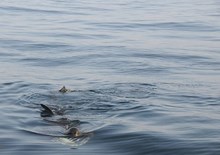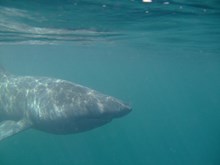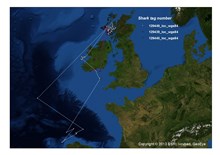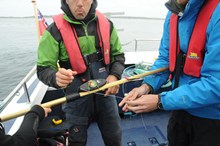21 January, 2016
Tagging project confirms Sea of the Hebrides importance to basking sharks
A pioneering three-year project to learn some of the secrets of Scotland’s basking sharks by using satellite tag technology has shown an area off the west coast to be truly important for these giant fish.
Sharks tracked during the Basking Shark Satellite Tagging Project tended to spend most of their summer in the Sea of the Hebrides and returned to the same area the following year, according to the final project report published by Scottish Natural Heritage (SNH) today (Thursday).
Between 2012 and 2014, 61 basking sharks were tagged in the project, a partnership between SNH and the University of Exeter (UoE), and the first known to use a variety of satellite tagging technologies and to track the near real-time movements of basking sharks.
Tags were attached to the sharks near the islands of Hyskier, Coll and Tiree, where each summer large numbers of basking sharks can be seen feeding near the surface. The tagged sharks were particularly drawn to the waters around these islands which are an exciting place for wildlife watchers. Scientists at SNH and UoE believe the sharks return each year to feed in the area’s plankton-rich seas. The sharks’ behaviour suggests the waters could also be important to the sharks for other reasons and that they could benefit from a proposed MPA off the west coast.
Suzanne Henderson from SNH, who is managing the project said:
“It’s been really exciting to learn that the same individual basking sharks return in consecutive years to use Scottish waters. It’s something we thought happened - but we now have the first proof that this occurs. It really does emphasise that the Sea of the Hebrides is highly important for this migrating species.”
Protecting highly mobile species, such as basking shark and whales, is difficult due to the large areas they cover. So identifying and managing areas where the animals gather to feed, or for important life-cycle events, such as courtship, can play an important role in their conservation.
As part of the Scottish MPA Programme, SNH has recommended that an area of the Sea of the Hebrides from Skye to Mull be designated an MPA to protect the basking sharks, and also minke whales. Scottish Ministers are currently considering the proposal.
Suzanne said:
“As well as cruising around and feeding at the surface the sharks can be seen showing courtship-like behaviours, such as jumping clear of the water, known as breaching and swimming around nose-to-tail. These social behaviours suggest that the sharks return to the area not just to feed on the plankton bloom but for other reasons too, perhaps even to find a mate.”
From autumn onwards the tagged sharks dispersed widely, leaving the shallow coastal waters for deep sea. Some were seen to head south as far as the Iberian Peninsula and North Africa, some headed west of Ireland and others remained relatively close to Scotland throughout the winter.
The Irish and Celtic Seas are also important for the basking sharks, the world’s second largest fish after the whale shark. According to the report most of the sharks that headed south in the autumn used these seas as a migration corridor towards the Isle of Man and southwest England.
Cabinet Secretary for Rural Affairs, Food and the Environment, Richard Lochhead said:
“The world’s second largest shark, the basking shark, is an iconic species for marine conservation. Up until now we have not known as much as we would have liked about what they do in our seas and how best to ensure their continued presence alongside us, however this satellite tracking study confirms the Sea of the Hebrides is an essential destination in the migratory cycle of these gentle giants, where large numbers are seasonally sighted.
“This partnership between our scientific advisors at SNH and the University of Exeter has succeeded in uncovering more of the basking shark’s secrets and furthering our knowledge of their behaviours, such as returning year on year to the same places at the same time. The results of this valuable work will help us along the path of getting the Marine Protected Area network right by ensuring the ecological processes and places basking shark depend upon are afforded the protection they need to endure.”
Tags which provided information on the sharks’ vertical movements suggest that the fish are able to adapt to various habitats and changes in their environment. A variety of behaviour was recorded, although sharks were found generally heading to deeper water at night in the summer months, returning to the surface during the day. Seven of the tagged sharks were found at depths greater than 1000m during winter months.
Matthew Witt from UoE said:
“We have learnt so much about Scotland’s basking sharks through this work. It is the first project to use such a range of the latest tagging technologies and this has allowed us to reveal the horizontal and vertical movements of basking sharks with high levels of accuracy.
“We have gathered large amounts of data from the tags, which performed exceptionally well. But to collect much of this information we needed to retrieve the tags after they had detached from the sharks, so we are extremely grateful to the public whose remarkable beach-combing abilities saw more than a quarter of the tags returned to us.
“It’s been a truly exciting project with many highlights and challenges along the way. It has improved our understanding of the life history of basking sharks and confirmed that the Sea of the Hebrides is a special place for these captivating fish. We hope our combined efforts yield a more secure future for basking sharks in coastal and offshore waters and that the impact of the project reaches far, influencing marine spatial planning policy, public engagement and the global conservation agenda.’
ENDS
The report is published on the SNH website and can be viewed via the link below:
A second report was also published today which can be viewed via the link below:
All reports produced under the project can be viewed via our Basking Shark Satellite Tagging Project webpage. Here you can also view a short video about sharks in the Sea of Hebrides and some FAQs about the project.
Additional free, colour pictures of basking sharks and the tagging work are available on request for one-off use. Please contact Dominic Shann, SNH media & public relations officer on 01463 725157 or dominic.shann@snh.gov.uk
Additional information about the tag
The tag is attached to the body at the base of the dorsal fin of the shark with a titanium metal dart using an extendable darting pole. There were four types of tag used. Thirty seven of the sharks were fitted with tags which provide information on the position of the shark each time it comes to the surface, allowing it to be tracked online. The remaining tags were designed to collect data on depth, temperature and light levels over several months and then detach from the shark. These tags then float to the surface and transmit collected data to satellites passing overhead. However, if they are physically retrieved then much more data can be collected.
Basking sharks can grow up to 11 m in length (the length of a double decker bus) and 7 tonnes in weight but they feed entirely on plankton, tiny animals that drift through the water. The plankton are caught in their enormous gaping mouth while the water is filtered out by their comb-like gills. They are long lived, with some surviving as long as 50 years. Because they are slow moving, slow to mature and long lived, they are very vulnerable to human disturbance and impacts. For generations they were hunted for the high oil content of their large livers. More recently they were hunted in European waters for their colossal fins.
Basking sharks are most often seen in coastal areas in the summer and autumn when plankton are abundant at the surface and this is how they get their name from apparently basking at the surface in calm, sunny weather.
Basking sharks in the North East Atlantic are recognised by the International Union for the Conservation of Nature (IUCN) as "endangered". Trade in their body parts is restricted by the Convention on the International Trade for Endangered Species (CITES). In the UK they are protected by the Wildlife & Countryside Act (1981), as amended.
Marine Protected Areas
To meet international commitments, Scotland is required to create a network of Marine Protected Areas (MPAs) in Scottish waters, under the Marine (Scotland) Act and the UK Marine and Coastal Access Act. The process is led by Marine Scotland. SNH's role is to provide information and advice about the marine environment in territorial waters to Marine Scotland and Ministers so they can decide where MPAs should be. The project also includes JNCC, Historic Scotland, Marine Scotland Science and the Scottish Environment Protection Agency.
Basking sharks are one of a number of important species and habitats on the list of Priority Marine Features (PMFs), developed to help target conservation work in Scottish waters. A related list of MPA search features includes basking sharks, and is helping to drive the selection of nature conservation MPAs.
Our Marine Protected Area advice to Scottish Government, including our advice relating to the Sea of the Hebrides proposal, is available on our website.
More information about the Scottish MPA process is available from:
Marine Scotland: www.scotland.gov.uk/Topics/marine/marine-environment/mpanetwork
SNH: www.snh.gov.uk/marine-protected-areas/
JNCC: www.jncc.defra.gov.uk/ScottishMPAs
About the University of Exeter
The University of Exeter is a Russell Group university and in the top one percent of institutions globally. It combines world-class research with very high levels of student satisfaction. Exeter has over 18,000 students and is ranked 8th in The Times and The Sunday Times Good University Guide league table, 10th in The Complete University Guide and 12th in the Guardian University Guide 2014. In the 2008 Research Assessment Exercise (RAE) 90% of the University’s research was rated as being at internationally recognised levels and 16 of its 31 subjects are ranked in the top 10, with 27 subjects ranked in the top 20. Exeter was The Sunday Times University of the Year 2012-13.
The University has four campuses. The Streatham and St Luke’s campuses are in Exeter and there are two campuses in Cornwall, Penryn and Truro. In a pioneering arrangement in the UK, the Penryn Campus is owned and jointly managed with Falmouth University. At the campus, University of Exeter students can study programmes in the following areas: Animal Behaviour, Conservation Biology and Ecology, English, Environmental Science, Evolutionary Biology, Geography, Geology, History, Human Sciences, Mathematics and the Environment, Mining and Minerals Engineering, Politics and International Relations, Renewable Energy and Zoology.
The University has invested strategically to deliver more than £350 million worth of new facilities across its campuses in the past few years; including landmark new student services centres - the Forum in Exeter and The Exchange at Penryn – together with world-class new facilities for Biosciences, the Business School and the Environment and Sustainability Institute. There are plans for another £330 million of investment between now and 2016. www.exeter.ac.uk/cornwall
Contact information
- Name
- Dominic Shann
- Job Title
- Media Relations Officer
- Telephone
- 01463 725157
- dominic.shann@nature.scot
NatureScot is Scotland's nature agency. We work to enhance our natural environment in Scotland and inspire everyone to care more about it. Our priority is a nature-rich future for Scotland and an effective response to the climate emergency. For more information, visit our website at www.nature.scot or follow us on X at https://x.com/NatureScot
’S e NatureScot buidheann nàdair na h-Alba. Bidh sinn a’ neartachadh àrainneachd na h-Alba agus a’ brosnachadh dhaoine gu barrachd suim a chur ann an nàdar. Tha e mar phrìomhachas againn gum bi nàdar na h-Alba beairteach agus gun dèilig sinn gu h-èifeachdach le èiginn na gnàth-shìde. Tha an tuilleadh fiosrachaidh aig www.nature.scot no air X aig https://x.com/NatureScot




